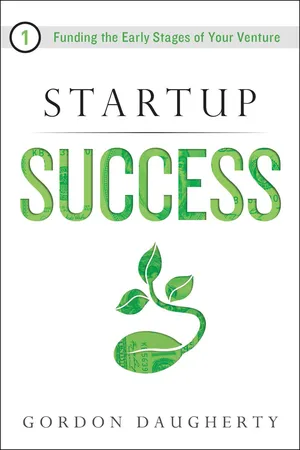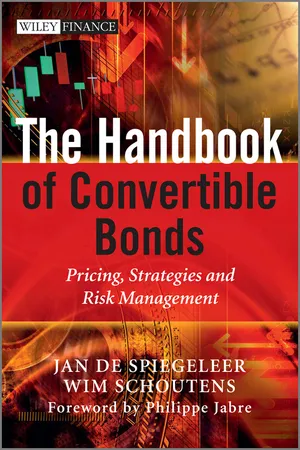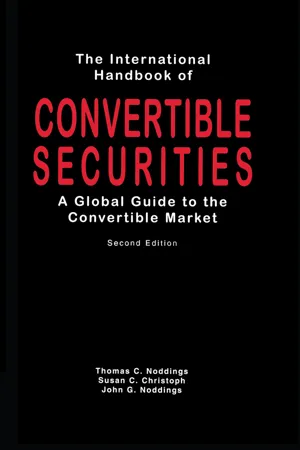Convertibles
Convertibles are hybrid securities that can be converted into a predetermined number of common stock shares. They offer investors the potential for capital appreciation through stock price increases, while also providing downside protection through their fixed-income characteristics. Convertibles are often issued by companies as a way to raise capital at a lower cost than issuing traditional debt or equity.
8 Key excerpts on "Convertibles"
- eBook - ePub
Private Capital Investing
The Handbook of Private Debt and Private Equity
- Roberto Ippolito(Author)
- 2019(Publication Date)
- Wiley(Publisher)
...No preference shares have all the abovementioned features; the precise details are specific to each issue. Convertibles Convertible securities (also referred to as ‘Convertibles’ or ‘converts’) include convertible loans, convertible bonds, and convertible preferred shares, plus variations on these themes. These securities enable investors (i.e. subscribers of convertible securities) to convert their fixed income investments into pre-specified amounts of an issuing firm's common stock through the establishment of a ‘conversion price’. The securities combine features from both debt and equity and have therefore been described as ‘hybrid’ instruments. The standard convertible security is a fixed income security with an option to convert the fixed income investment into common stock. The fixed income instrument – usually a loan, a bond, or a preferred share – offers a set schedule of ‘fixed’ cash flows in the form of interest, coupon, or dividend payments. The option to convert the security gives the right to exchange the bond or preferred share for a certain number of shares of the issuer's common stock. The security can be issued such that it can be traded for common stock at a set share price (‘conversion price’). If a conversion price is given, the conversion ratio is easily calculated, and vice versa. Convertible bonds are, in other words, corporate bonds with a call option (right to purchase) on the company's shares: the convertible bondholder is in fact in a similar position to that of a holder of a bond plus a warrant (equal to a call option), but the position is different in that, at conversion, the convertible bondholder will give up the bond in order to exercise the call option. The bond-warrant holder can exercise the warrant for cash and keep the bond...
- eBook - ePub
Introduction to Fixed Income Analytics
Relative Value Analysis, Risk Measures and Valuation
- Frank J. Fabozzi, Steven V. Mann(Authors)
- 2010(Publication Date)
- Wiley(Publisher)
...CHAPTER 10 Analysis of Convertible Bonds Corporations must fund their operations by selling claims to the expected future cash flows they generate. The two basic claims issued are debt and equity. Debt claims are fixed by contract; equity claims are residual. Between these two endpoints, there exists a continuum of securities that possess features of both debt and equity. Among the most prominent of these hybrid securities is convertible bonds. A convertible bond is a combination of an option-free bond and the option to convert the bond into a given number of shares of the issuer’s common stock. Convertible bonds are typically callable and may be putable. Depending on the performance of the underlying stock, a convertible bond may behave more like a common stock or more like an option-free bond. In its most basic form, a convertible bond represents a combination of an option-free bond and call option on the underlying common stock. Specifically, a convertible bond is a security that gives the investor the option to convert into a specified number of shares (adjusted for stock splits/stock dividends) of the issuer’s common stock. This differs from an exchangeable bond, which gives investors the option to exchange their bond for the common stock of a firm other than the issuer. Valuation of Convertibles presents some challenges to the analyst. For example, the exercise price for the conversion option is surrendering a bond whose price changes. Moreover, convertible bonds issued today typically possess more than one embedded option. As noted above, these bonds can be callable and/or putable...
- eBook - ePub
Startup Success
Funding the Early Stages of Your Venture
- Gordon Daugherty(Author)
- 2019(Publication Date)
- River Grove Books(Publisher)
...You should also understand the most sensitive issues from the investor’s perspective. CONVERSION BASICS As the name suggests, convertible securities are intended to convert into something, and that something is equity. Most investors want equity in your company and are willing to invest now while waiting until certain conditions are suitable to actually get that equity. More specifically, they are willing to wait until they can get a preferred class of equity. At a basic level, convertible securities are simple. They convert an investor’s invested capital into preferred equity once you create and sell that class of shares to future investors in an equity round of funding. With this, investors in both the early and later rounds of funding end up with the same preferred shareholder rights. But even though the basics of convertible security mechanics are simple, the devil is in the details. Let’s start with the standard terms for most forms of convertible securities. DEFINITION: CLASSES OF STOCK There are typically two broad classes of stock created over time. Before taking on external funding, most startups only have what is referred to as common stock. But later, when professional investors put money into the company, they want special rights for economic protection and an element of protectionary control. These extra rights define a new class of shares referred to as preferred shares. In this way, a class of stock denotes a group of shareholders with the same rights. Sometimes this results in multiple subclasses of shares being created to further differentiate the rights of a larger class. In other words, a company might have Series Seed Preferred, Series A-1 Preferred, and Series A-2 Preferred classes of stock, each with a different set of rights, even if only slightly different...
- eBook - ePub
The Handbook of Convertible Bonds
Pricing, Strategies and Risk Management
- Jan De Spiegeleer, Wim Schoutens(Authors)
- 2011(Publication Date)
- Wiley(Publisher)
...A convertible bond is a security in which the investor can convert the instrument into a predefined number of shares of the company that issued the bond. This conversion is, by default, not mandatory and is an option for the investor. Convertible bonds are not new. We have to go back as far as 1881 to find the issue of the first convertible bond. The railroad magnate J.J. Hill needed an innovative way to finance one of his new projects because nobody was interested in buying any equity when he wanted to increase the capital in his railroad company. The convertible bond market has evolved a lot since this first issue more than a century ago, but the principle of mixing debt and equity in one single instrument remains the same. The final payoff of the convertible bond is written as: (1.1) The holder of this convertible has the right, at maturity, to swap the face value N of the bond for C r shares with price S, where C r is the conversion ratio. Hence, a simplified definition of a convertible bond is a bond with an embedded call option. Rewriting (1.1) and abstracting from the fact that the convertible might pay coupons illustrates this: (1.2) The above argument is only possible when the conversion is restricted to the maturity of the convertible bond. Actually, by put–call parity, holding a convertible bond is also economically the same as holding C r shares combined with a European put option to sell these shares in return for the face value N of the convertible bond: (1.3) Some simplified valuation methods support this breakup. These methods try to value a convertible as a package consisting of a European option on a stock and a corporate bond. Convertible bonds are issued by corporates (the issuer) but we cannot simply categorize them as debt. They rank before the common stockholders, and their behaviour can move from being a pure bond to an equity-like security...
- eBook - ePub
Business
The Ultimate Resource
- Bloomsbury Publishing(Author)
- 2011(Publication Date)
...Where a company has a good track record and aggressive growth plans, however, it may benefit both investors and the company, especially if the management can maintain (or increase) profit margin. TRICKS OF THE TRADE • Preferred stocks and other convertible securities offer investors a hedge: fixed-interest income without sacrificing the chance to participate in a company’s capital appreciation. • When a company does well, investors can convert their holdings into common stock that is more valuable. When a company is less successful, they can still receive interest and principal payments, and also recover their investment and preserve their capital if a more favorable investment appears. FOR MORE INFORMATION Web Site: Equity Analytics Limited: www.e-analytics.com “Think and act; to act and then think is folly.” Tiruvalluvar...
- eBook - ePub
- Paul Wilmott(Author)
- 2013(Publication Date)
- Wiley(Publisher)
...In the long term, if they are successful, they will hand over shares to happy investors. On the other hand, CBs can be issued by more speculative firms who would then be tempted to take risks with the capital so raised. What is their downside? The convertible bond has characteristics that make it sometimes behave like stock, and sometimes like a bond. The conversion feature of convertible bonds also makes these contracts similar to American options. The question of when to exercise an American option is very similar to the question of when to convert a convertible bond. It is this ‘optionality’ that adds value to the convertible bond. CBs are different from options, however, in that on conversion, new shares are issued. The CB is an example of a hybrid instrument since it has features of both equity and debt. 33.2.2 The Issuers of CBs CBs are issued by corporations. These companies are often not of the highest quality, in terms of credit risk. By selling bonds which can be later converted to equity the issuer can get away with a lower coupon than might otherwise be expected. 33.2.3 Why Issue a Convertible? Corporations in need of capital have many choices available to them. These choices have two common themes: Issue equity; Issue debt. Issue equity: Dilutes earnings per share but has low initial financing costs. Issue debt: Does not dilute earnings per share but may have high initial financing costs. The other possibility is to issue a hybrid instrument with both of these features: The Convertible Bond. The bond can be sold with a lower coupon than a plain bond with the same maturity and price. (Or equivalently, it can be sold for a higher price with the same coupon.) It does not dilute earnings per share, until the bond is converted and new shares are issued. If the bond is converted, the principal does not have to be repaid. The typical issuer of CBs has high cash requirements, perhaps with a very rapid use of cash and low credit quality. They may be startups...
- eBook - ePub
- Thomas Noddings, Susan C. Christoph, John G. Noddings(Authors)
- 2013(Publication Date)
- Routledge(Publisher)
...Introduction Introduction This is the second edition of The International Handbook of Convertible Securities, which was originally published as The Irwin Yearbook of Convertible Securities (Irwin Professional Publishing, 1995). It updates and expands statistical and performance data for the domestic (U.S.) convertible securities market, the international convertible securities markets, and mutual funds specializing in Convertibles, and contains a detailed glossary of terms applying to convertible securities. Readers will find a broad examination of the convertible securities market and its numerous applications, useful insights on how to make it all work, and guidance on how to evaluate performance of convertible securities. This handbook will be most useful to those responsible for investing funds within the financial markets (public and private pension plans, corporations, endowments, family offices, and individual investors). Financial advisors (consultants, financial planners, and other portfolio strategists) who counsel investors at all levels may also find it invaluable. Designed as a practical working guide, this handbook bypasses complex mathematical formulas; the examples have been carefully designed to illustrate situations clearly. To facilitate the serious investor’s understanding of convertible securities and their risk-reward characteristics, it highlights the potential of convertible securities to enhance portfolio returns while reducing risk. It relates Convertibles to conventional financial investments like stocks, bonds, and money market instruments and shows how they can totally replace traditional investing. The Convertible Securities Market Convertible securities are generally understood to include equity warrants, convertible bonds, and convertible preferred stocks. Excluded from the definition are equity and index options and structured convertible products (mandatories) such as PERCS and DECS...
- eBook - ePub
Venture Deals
Be Smarter Than Your Lawyer and Venture Capitalist
- Brad Feld, Jason Mendelson(Authors)
- 2019(Publication Date)
- Wiley(Publisher)
...CHAPTER 8 Convertible Debt In the past few chapters, we’ve gone through the exhaustive, but hopefully not exhausting, terms in a typical venture capital equity financing. As we foreshadowed previously, the popularity of convertible debt has grown over the years. Today, many angel investors and accelerators invest primarily using convertible debt. In the majority of cases, unless the company fails to raise any more money, this is a temporary state of financing, because the debt is intended to convert into equity at a later date. So, what is convertible debt? Simple. It’s debt. It’s a loan. With a loan, you don’t have to argue about valuation, although you may argue about potential future valuations using the concept of a valuation cap, which we will discuss further on. The fundamental notion is that when a company raises a future round of equity financing, the money loaned to the company via the convertible debt round converts into whatever type of stock the company sells under whatever terms it agrees to in the future. In exchange for the convertible debt, the investors get a modest interest rate and typically convert at a discount to the price to the next round. For example, assume you raise $500,000 in convertible debt from angels with a 20% discount to the next round, and six months later a VC offers to lead a Series A round of a $1 million investment at $1 a share. Your financing will actually be for $1.5 million total, although the VCs will get 1 million Series A shares ($1 million at $1 per share) and the angels will get 625,000 Series A shares ($500,000 at $0.80 per share). The discount is appropriate, since your early investors want some reward for investing before the full Series A financing round comes together. In this chapter, we cover the arguments for and against using convertible debt...







